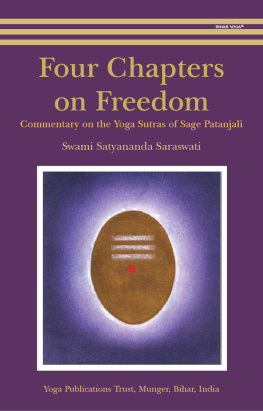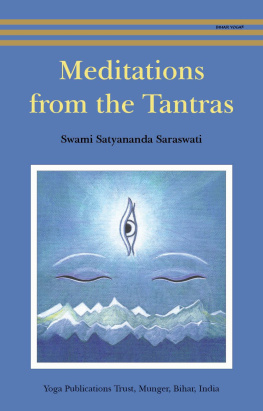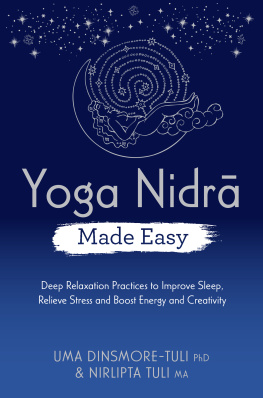Yoga Nidra
With kind regards,

and prem
Yoga Nidra
Swami Satyananda Saraswati
Yoga Publications Trust, Munger, Bihar, India
Y OGA P UBLICATIONS T RUST
Yoga Nidra
Satyananda Yoga Nidra is a simple yet profound technique adapted by Swami Satyananda Saraswati from the traditional tantric practice of nyasa. This text explains the theory of yoga nidra in both yogic and scientific terms and includes class transcriptions of the practice. It also presents the various applications of this versatile technique, which has been used for deep relaxation, in stress management and therapy, to enhance the learning process in education, to harmonize the deeper unconscious and awaken inner potential, and as a meditative technique. A research section is also included.
This systematic method of inducing complete mental, emotional and physical relaxation is suitable for all practitioners.
Many sannyasins have selflessly contributed to the compiling, editing and publishing of this text. To one and all, yoga aspirants extend their gratitude for bringing this information to them.
Bihar School of Yoga 1976, 1977, 1978, 1982, 1993, 1998, 2015
All rights reserved. No part of this publication may be reproduced, transmitted or stored in a retrieval system, in any form or by any means, without permission in writing from Yoga Publications Trust.
The terms Satyananda Yoga Nidra, Satyananda Yoga and Bihar Yoga are trademarks owned by International Yoga Fellowship Movement (IYFM). The use of the same in this book is with permission and should not in any way be taken as affecting the validity of the marks.
The purpose of this book is to provide relevant information regarding yoga practice; it is not to be used for teaching oneself or others. All yoga training and learning should be done under the guidance of an experienced, competent teacher, not from the book alone.
Published by Bihar School of Yoga
First published 1976
Second edition 1977
Third edition 1978
Fourth revised edition 1982
Fifth edition 1993
Sixth edition 1998
Published by Yoga Publications Trust
Reprinted 2001 (twice), 2003, 2005, 2006 (twice), 2008, 2009, 2012, 2015
First digital edition 2016
ISBN (print): 978-81-85787-12-1
ISBN eMOBI: 978-93-84753-29-0
ISBN ePUB: 978-93-84753-30-6
Publisher and distributor: Yoga Publications Trust, Ganga Darshan, Munger, Bihar, India.
Website: www.biharyoga.net
Dedication
In humility we offer this dedication to
Swami Sivananda Saraswati, who initiated
Swami Satyananda Saraswati into the secrets of yoga.
Contents
Y oga nidra, which is derived from the tantras, is a powerful technique in which you learn to relax consciously. In yoga nidra, sleep is not regarded as relaxation. People feel that they are relaxing when they collapse in an easy chair with a cup of coffee, a drink or a cigarette, and read a newspaper or switch on the television. But this will never suffice as a scientific definition of relaxation. These are only sensory diversions. True relaxation is actually an experience far beyond all this. For absolute relaxation you must remain aware. This is yoga nidra, the state of dynamic sleep.
Yoga nidra is a systematic method of inducing complete physical, mental and emotional relaxation. The term yoga nidra is derived from two Sanskrit words, yoga meaning union or one-pointed awareness, and nidra which means sleep. During the practice of yoga nidra, one appears to be asleep, but the consciousness is functioning at a deeper level of awareness. For this reason, yoga nidra is often referred to as psychic sleep or deep relaxation with inner awareness. In this threshold state between sleep and wakefulness, contact with the subconscious and unconscious dimensions occurs spontaneously.
In yoga nidra, the state of relaxation is reached by turning inwards, away from outer experiences. If the consciousness can be separated from external awareness and from sleep, it becomes very powerful and can be applied in many ways, for example, to develop the memory, increase knowledge and creativity, or transform ones nature.
In the raja yoga of Patanjali there is a state called pratyahara where the mind and mental awareness are dissociated from the sensory channels. Yoga nidra is one aspect of pratyahara which leads to the higher states of concentration and samadhi.
The birth of yoga nidra
When I was living with my guru, Swami Sivananda, in Rishikesh, I had a very important experience which triggered my interest in developing the science of yoga nidra. I had been appointed to watch over a Sanskrit school where small boys were learning to chant the Vedas. It was my duty to remain awake all night to guard the school while the acharya was away. At three a.m. I used to fall into a deep sleep, and at six I would get up and return to the ashram. Meanwhile, the boys got up at four, bathed and chanted Sanskrit prayers, but I never heard them.
Some time later, my ashram was holding a large function, and the boys of that Sanskrit school were brought to chant the vedic mantras. During the function they recited certain slokas which I did not know, yet somehow I felt that I had heard them before. As I listened, the feeling grew stronger, and I tried in vain to remember where and when I had heard them. I was absolutely certain that I had never read or written them, yet they sounded so familiar to me.
Finally, I decided to ask the boys guru, who was seated nearby, if he could explain the meaning of this. What he told me changed my entire outlook on life. He said that this feeling of familiarity was not at all surprising, because my subtle body had heard the boys chanting the same mantras many times while I was sleeping in their school. This was a great revelation to me. I knew that knowledge is transmitted directly through the senses, but from this experience I realized that you can also gain direct knowledge without any sensory medium as well. That was the birth of yoga nidra.
From that experience, further ideas and insights came to my mind. I realized that sleep was not a state of total unconsciousness. When one is asleep, there remains a state of potentiality, a form of awareness that is awake and fully alert to the outer situations. I found by training the mind, it is possible to utilize this state.
Tantric origin
After this discovery, I began studying the tantric scriptures in a new light. I came across many important but little known practices, which interested me greatly. After practising them myself, I decided to construct a new system called yoga nidra which would incorporate the essence of these practices without having complicated ritualistic drawbacks.
The characteristic feature of yoga nidra was the systematic rotation of consciousness in the body, which originated from the tantric practice of nyasa (meaning to place or to take the mind to that point). Nyasa was practised in a sitting posture and involved the use of specific mantras which were placed, felt or experienced at different parts of the body. First the name of the part was recited, then it was visualized or touched, and the mantra was placed there. Nyasa was a means of consecrating the physical body by instilling higher awareness or divine consciousness into the various parts during tantric ritual practices. For example, the Angushtadi-Shadanga-nyasa was used to place mantras in the hand as follows:









 and prem
and prem

